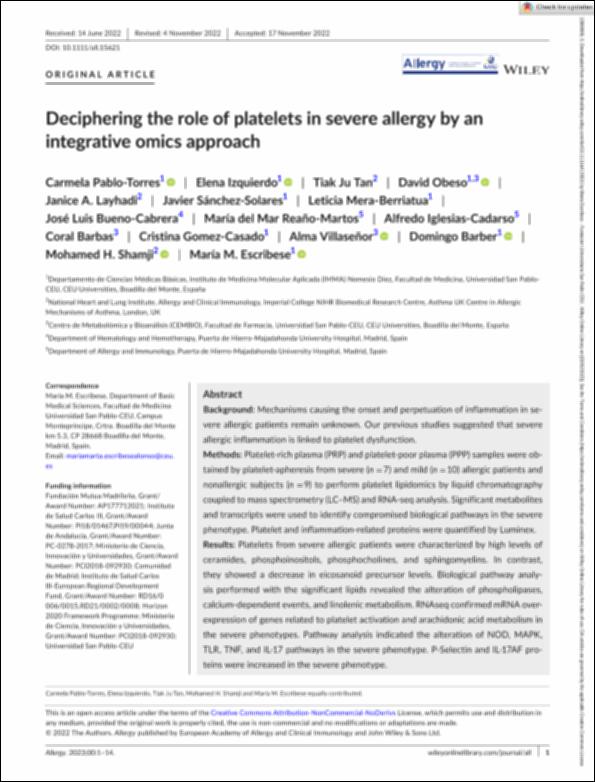Please use this identifier to cite or link to this item:
http://hdl.handle.net/10637/14116Deciphering the role of platelets in severe allergy by an integrative omics approach.
| Title: | Deciphering the role of platelets in severe allergy by an integrative omics approach. Descifrando el papel de las plaquetas en la alergia severa mediante un enfoque ómico integrador |
| Authors : | Pablo-Torres, Carmela Izquierdo Álvarez, Elena Ju Tan, Tiak Obeso Montero, David Layhadi, Janice A. Sánchez-Solares, Javier Mera Berriatua, Leticia Bueno-Cabrera, José Luis Reaño-Martos, María del Mar Iglesias-Cadarso, Alfredo Barbas Arribas, Coral. Gómez Casado, Cristina Villaseñor Solis, Alma Cristina Barber Hernández, Domingo H. Shamji, Mohamed Escribese Alonso, María Marta |
| Keywords: | Allergy; lipidomics; metabolomics; platelets; RNAseq |
| Publisher: | Wiley |
| Citation: | Pablo-Torres C, Izquierdo E, Tan TJ, et al. Deciphering the role of platelets in severe allergy by an integrative omics approach. Allergy. 2023;00:1-14. doi:10.1111/all.15621 |
| Abstract: | Background: Mechanisms causing the onset and perpetuation of inflammation in severe allergic patients remain unknown. Our previous studies suggested that severe allergic inflammation is linked to platelet dysfunction. Methods: Platelet-rich plasma (PRP) and platelet-poor plasma (PPP) samples were obtained by platelet-apheresis from severe (n = 7) and mild (n = 10) allergic patients and nonallergic subjects (n = 9) to perform platelet lipidomics by liquid chromatography coupled to mass spectrometry (LC–MS) and RNA-seq analysis. Significant metabolites and transcripts were used to identify compromised biological pathways in the severe phenotype. Platelet and inflammation-related proteins were quantified by Luminex. Results: Platelets from severe allergic patients were characterized by high levels of ceramides, phosphoinositols, phosphocholines, and sphingomyelins. In contrast, they showed a decrease in eicosanoid precursor levels. Biological pathway analysis performed with the significant lipids revealed the alteration of phospholipases, calcium-dependent events, and linolenic metabolism. RNAseq confirmed mRNA overexpression of genes related to platelet activation and arachidonic acid metabolism in the severe phenotypes. Pathway analysis indicated the alteration of NOD, MAPK, TLR, TNF, and IL-17 pathways in the severe phenotype. P-Selectin and IL-17AF proteins were increased in the severe phenotype. Conclusions: This study demonstrates that platelet lipid, mRNA, and protein content is different according to allergy severity. These findings suggest that platelet load is a potential source of biomarkers and a new chance for therapeutic targets in severe inflammatory pathologies. |
| URI: | http://hdl.handle.net/10637/14116 |
| Rights : | http://creativecommons.org/licenses/by-nc-nd/4.0/deed.es openAccess |
| ISSN: | 1398-9995 (Electrónico) |
| Supported by: | Acuerdo Transformativo - 2023 |
| Issue Date: | 17-Dec-2022 |
| Center : | Universidad San Pablo-CEU |
| Appears in Collections: | Medicina |
Items in DSpace are protected by copyright, with all rights reserved, unless otherwise indicated.


